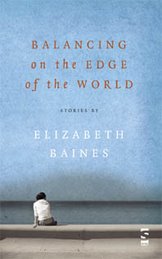Jenny chose this book because, she said beforehand, her daughter is teaching it in Toronto. At the meeting she said that what attracted her to it also, and the reason she liked it when she came to read it, is that it is indeed set in Toronto, which she knows very well, and she always likes books set in named places she knows, with street names and landscape she can identify. This is interesting to me as a writer, since however closely my settings are based on real-life ones, I often don't name them in an attempt to universalize: I have the sense that if readers aren't familiar with the real-life places, pinning them down with names can create an effect of alienation, a jarring injection of reality which can potentially destroy the spell of story.
Jenny then went on to describe Toronto to us, its great canyon dividing the city and its various immigrant communties - the book very much concerns an immigrant community - and a discussion started up, mainly between Jenny and Trevor, about how quickly immigrant societies become assimilated in various cities, and whether or not the geography of Toronto has slowed the process down.
Feeling vindicated in my view, I said, But what about the book? A concern with facts was leading us right away from it, a book with indeed an atmosphere closer to myth or dream than the factual accounts of history or geography.
Jenny said she thought it was a book about identity, which seemed to me an astute assessment. Set in the 1920s around the building of the Bloor Street Viaduct which will bridge the city, it is essentially the story of Patrick, who, like the moths he watched flinging themselves against the lighted windows in his isolated country childhood, comes to Toronto 'searching', for a home, or an identity, or maybe a narrative of his own, but drawn with the logic and coincidence of dream into the stories of others, and in particular the immigrant Macedonian community. As Trevor said, the blurb on his edition bills the book as a love story, but it's not really, or rather it's more complicated than that. As in dreams, and as in Ondaatje's better-known sequel The English Patient, love stories become displaced from the centre, are left hanging or morph: a nun falls from the bridge and is caught by the worker Nicholas, an incident that hangs over the rest of the story like an iconic miracle, bonding the two souls together, yet later we will learn that Nicholas has married another. Indeed, as in dreams, characters central to the The English Patient appear on the edges here, waiting in the wings with the centrality of their own narratives. The language too is dream-like, and there are constant references to dreams - The bridge goes up in a dream - and, as in The English Patient there is the ache of loss and longing that characterises the most affecting dreams. Right from the start we are clear that the whole thing is couched in the dream of narrative:
This is a story a young girl gathers - note that word 'gathers': like daydreams? - in a car in the early hours of the morning... She listens and asks questions as the vehicle travels through darkness. The man who is driving could say, 'In that field is a castle', and it would be possible for her to believe him. (My bolds.)Trevor said with a big grin that this was the most romantic book he had ever read, with all its coincidences and miracles, in fact quite frankly it was a load of bollocks, but that wasn't a criticism, he had really loved it. Doug, and especially Ann said they had found it frustrating with its shifts of focus and unbelievable coincidences. Some people didn't even agree with me that what they thought of as two characters were the same woman (I won't plot-spoil here), the coincidence would be too forced.
All of this seemed to me too literal a reading of a book not intended to be so read, but I did have to agree that while for me The English Patient succeeds by drawing me into its dream, I too often had the sense here of being on the outside observing the author's dream, a problem compounded by the fact that the characters are constantly having their own affecting dreams.
John told Jenny that he had been absolutely sure that she would hate this book with its psychological dimension and poetic prose, since what she likes best is a good clear story. Jenny grinned and agreed that that last is true, but she still really liked this book.
Our archive discussions can be found here and a list of the books we have discussed, with links to the discussions, here











4 comments:
Five years on from my first reading, In the Skin of a Lion is still my favouite novel. I love the rich prose and the weaving of real lives into a highly engrossing novel - though I do think the improbability that exists to make heroes of men and props of women is overstated at times - it is a deeply symbolic and poetic take on historiography.
Yes, I should have mentioned that mixing of real-life figures and fictional events. It's another displacement that works in the way of dreams, and which makes the novel precisely a comment on historical/geographical readings of fiction.
Hi. Can u tell me 5 places in Toronto that are discussed in the novel ??
No, sorry! It's now ten years since we read and discussed the book, and I would have to read it again to tell you such detail!
Post a Comment